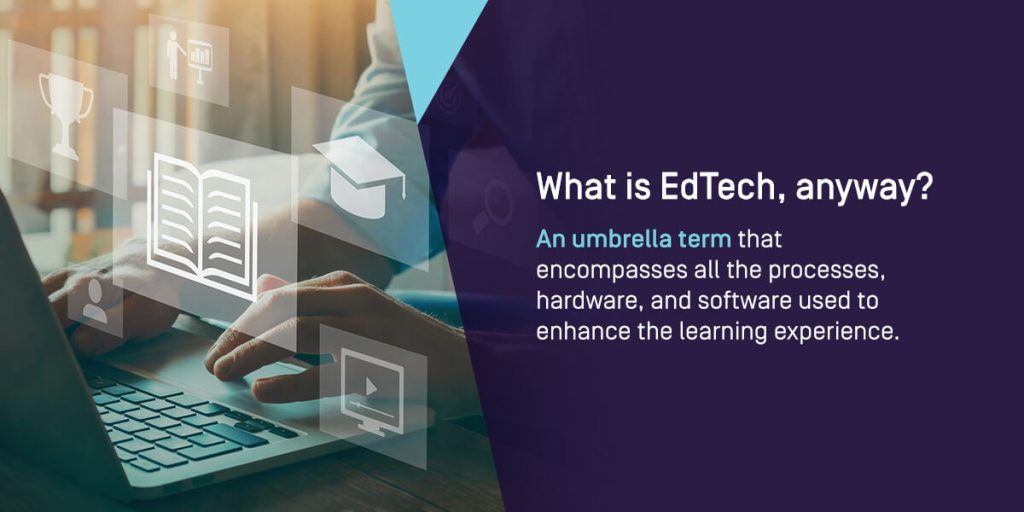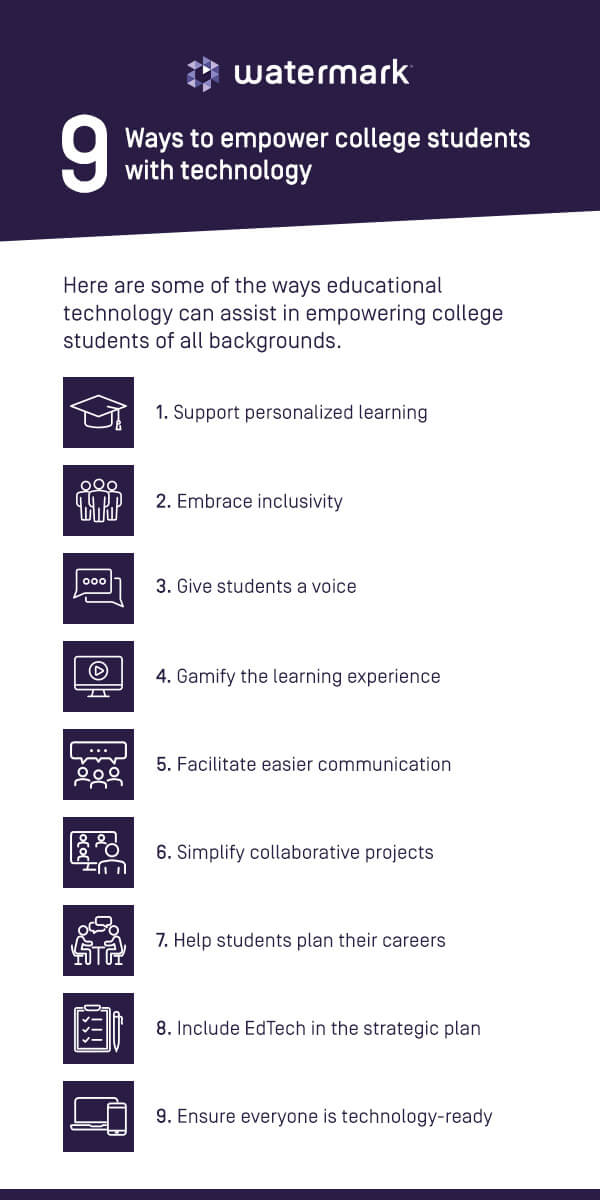
Too often, the traditional learning environment robs students of their autonomy — even in higher education. Students frequently rely on their instructors to guide them through a course, which reduces their opportunities to truly take ownership of their learning.
Students who feel empowered in their studies are more likely to succeed both in and outside the classroom because they have the confidence to bring their new knowledge and skills from the lecture hall to their everyday lives. So, how does technology empower students? Simple — it expands their ability to maximize their time in higher ed.
Although most higher education institutions have already incorporated edtech solutions in some way, there are still many opportunities to use these investments to improve the student experience.
What is edtech, anyway?
“Education technology,” commonly shortened to edtech or edutech, is an umbrella term that encompasses all the processes, hardware, and software used to enhance the learning experience.

It can take many different forms:
- Learning management system (LMS): An LMS is a centralized platform that hosts all of a course’s digital learning materials, including but not limited to exams, homework assignments, and readings.
- Student information system (SIS): An SIS is a software platform that consolidates student data into one location for easier processing and management.
- Classroom games: Interactive games like Kahoot! and Slides With Friends let classmates compete against each other, helping build rapport among peers and motivating students to participate in class.
- Interactive displays: Digital tools can help instructors more effectively communicate information during class. For example, SMART boards enhance the traditional whiteboard by allowing instructors to mark up projector displays in real time. Virtual whiteboards are similar in that they give instructors and online students the ability to collaborate with each other on the same canvas.
- Online course materials: Digital textbooks, videos, and other learning materials enable students to learn from anywhere, at any time that works for them.
- Data analytics platforms: Institutional data analytics platforms allow administrators to gain greater visibility into their institution at every level, empowering them to commit to a culture of continuous improvement.
The edtech industry is massive — and still growing! Experts predict the global market will expand at a compound annual growth rate of 13.6 percent over the next decade. And with new solutions rolling out every year, now is the best time to implement edtech in your institution.
Benefits of technology in higher education
While most institutions already have an established tech stack, some still have yet to invest in modern education solutions. Empowering students through technology is one of the many benefits, but the right tools can also help the institution as a whole.
Here are just a few of the benefits of incorporating edtech into your higher education institution:
- Higher engagement: Instructors can use various technologies to help students connect more with course content. For example, a professor could use social media to post discussion prompts and award extra credit to students who comment.
- Greater flexibility: Mobile apps and devices allow students to learn both in and outside the classroom, opening the door for more flexible class formats.
- Increased student retention: When students engage fully with their coursework and have the support they need to balance their education and their personal lives, they’re more likely to remain at your institution.
- More inclusive environments: Technology can make classes more accessible to students with disabilities, increasing their chances of finishing their education.
- Improved enrollment yield: Analyzing internal and labor market data can help you better market your institution to prospective students, boosting enrollment numbers and bringing in more revenue.
Choosing the right solution is essential. Look for one that integrates with the rest of your existing tech stack to simplify data transfer across your institution. Additionally, on-demand reporting features with interactive dashboards help you clearly articulate the narrative behind your data whenever and wherever you need it.
9 ways to empower college students with technology
Technology simplifies processes that were once long and overly complex, which reduces barriers for college students and helps them build confidence in their own abilities. Here are some of the ways educational technology can assist in empowering college students of all backgrounds.

1. Support personalized learning
Everyone is unique in their backgrounds, needs, and learning styles, which is why traditional teaching methods and curricula are falling out of fashion. Personalized learning programs give students ownership of their educational journeys so they can get the most value possible.
That’s where the right software comes in. With a robust digital infrastructure in place, institutions can allow students to tailor their higher ed experiences to their needs through flexible scheduling and individualized degree programs.
For example, one student may need to take a break from classes in the middle of the day to go home and tend to a family member. Providing a hybrid class format allows her to choose whether she attends class online or in person so she can more easily balance her coursework and personal life.
2. Embrace inclusivity
Students who feel like they have a chance at finishing their education are far more likely to continue than those who are struggling without support. Unfortunately, many students with disabilities fall into the latter category simply because their institutions don’t consider universal design when implementing technology.
Edtech solutions with accessibility features like text-to-voice software and color overlays help students with disabilities participate more fully in class. Combining these programs with campus support systems creates an environment that allows students of all ability levels to build confidence and take ownership of their education.
Accessibility is also a necessary consideration for compliance with the American Disabilities Act (ADA) — and failure to adhere to the requirements outlined in Section 508 and WCAG 2.1 can lead to serious consequences for your institution. Being proactive and making accessibility a priority is essential in choosing which edtech solutions your institution will use.
3. Give students a voice
Aside from classroom discussions, there are few opportunities for students to practice expressing their opinions to an audience. Most assignments are meant to be viewed by the instructor and the instructor only, but having an audience for your writing means you have to learn critical skills like formulating an argument and responding to criticism. Instructors can use social technology like online forums to encourage students to discuss course topics outside of the classroom, providing an excellent opportunity to hone those skills.
Additionally, student feedback is essential for course evaluations and curriculum review. When students know their suggestions can make a difference, they’ll feel more empowered to speak up any time they have something important to say. Well-designed anonymous surveys give students the perfect space to share their thoughts without pressure so they can contribute to your institution’s improvement.
4. Gamify the learning experience
Gamification is one of the most straightforward applications for edtech. It’s an approach to education that incorporates strategic game elements into a course to create a more engaging, interactive learning environment.
The ability to earn badges and points motivates students to complete study exercises outside the classroom, and leaderboards encourage friendly competition among classmates. Students can clearly visualize their progress within the course, which can empower them by showing them how far they’ve come and how much they still have yet to master.
Plus, gamification can help students remember information better through repetition, improving their ability to perform well in classes.
5. Facilitate easier communication
Establishing a sense of belonging helps students feel safe and grounded in the institution’s community, which empowers them to engage more fully in academic life.
Edtech platforms help build that foundation by making it easier to get in touch with classmates, faculty members, and staff. By centralizing everyone’s contact information into a directory within the application, these solutions save valuable time for both students and staff. Easy access to this information greatly increases the chances that a student will reach out any time they need help.
Edtech can also help faculty members optimize their schedules to better serve their students. For example, a professor teaching a full courseload could use video conferencing platforms like Zoom or Google Meet to open virtual office hours when they can’t physically be on campus. And students could ask urgent questions outside office hours using integrated direct messaging channels.
Some advanced solutions also integrate with scheduling software like Microsoft Outlook and Google Calendars, so students can schedule in-person appointments with faculty and staff directly through the application. Automated reminders keep them accountable so they remember their meeting.
6. Simplify collaborative projects
For many students, group projects are unnecessarily stressful. Coordinating times to meet up when everyone has to balance internships, research, and extracurricular activities often results in unequal distributions of labor within the group, which puts some students at a disadvantage. The problem is that collaboration is a critical skill in almost every occupation — not programming group projects means students miss out on opportunities to practice working as a team.
Fortunately, technology makes collaboration far more manageable. Web-based collaboration platforms like Google Docs let students work on the same document simultaneously, even when they’re in different places. This flexibility means students can tackle group projects and other collaborative work more efficiently, so they can produce the best work on time.
Additionally, version control features ensure students always have access to the latest version of their documents. And if they need to go back and change something, they can easily restore a previous version.
7. Help students plan their careers
When determining how to empower college students, one of the best things a higher education institution can give them is hope for their futures. When students can clearly connect the skills they’re learning in class to their intended career path, they’ll feel more motivated to fully engage with their education.

For example, a data analytics solution that examines labor market data can provide valuable insights into what skills are most in demand in a student’s chosen field. This information can help them plan out their educational journey in advance and ensure they develop the skills they need to be successful after graduation.
Edtech also opens up opportunities for students to gain experience in their chosen fields before they graduate. For example, some institutions use university job boards like Handshake to give their students access to internship and work opportunities.
8. Include edtech in the strategic plan
New technology is a major investment — and when your institution doesn’t view implementing a new software solution as an important decision, you’re more likely to push it off to the next review period. But building edtech into your institution’s strategic plan solidifies it as a commitment.
The key to winning stakeholders over is to focus on how the new solution benefits and empowers your students. You can build a sound case that justifies the investment using data your institution already collects, such as:
- Graduation rates.
- Transfer rates.
- Skill progression.
- Assessment scores.
- Enrollment and retention rates.
Your data is essential for making decisions that satisfy your stakeholders and enhance the learning experience for your students. Using the right analytics technology can help you generate actionable insights that inform your decisions.
For example, a solution with interactive dashboards and configurable report templates can help you bring all your stakeholders on the same page during reviews. It can also help you clearly communicate exactly which features most benefit your students and how.
9. Ensure everyone is technology-ready
Many of today’s college and university students are “digital natives” — Millennials and Gen Z who grew up surrounded by digital technology. These students are innately tech-savvy, often able to pick up a new software program or device and figure out how to use it without instruction.
While learning to use new edtech systems is a breeze for these students, older students may need additional support from your institution — especially if they haven’t been in school for a while. Helping these students succeed is essential for encouraging them to continue their education.
Some institutions offer one-on-one digital literacy mentorship programs to help these students learn the skills they need to succeed in a digital environment. Others have dedicated services students can use to find affordable tech near them, making digital learning more accessible to students of varying economic backgrounds.
It can help to conduct a tech-readiness survey at the beginning of each academic year to assess where your students are in terms of digital proficiency. The data from this survey can inform your investment into support services as well as identify which students would benefit most from them.
See how technology can empower students with Watermark
Today’s higher ed landscape requires a totally different approach from years past. At Watermark, we’ve made it our mission to help higher education institutions leverage data to future-proof every aspect of their organization, from the classroom to the administration.
Our comprehensive software suite includes Watermark Student Success & Engagement, an AI-powered student success solution that helps institutions proactively identify and empower students who are struggling. Automated alerts empower student support services to step in with personalized solutions and recommendations, improving the chances that the student will receive the help they need to get back on track.
Plus, turnkey integrations with other Watermark products and leading edtech platforms provide a seamless flow of student information across your entire ecosystem — so your institution can spend less time on manual data entry and apply its entire focus on serving its students effectively.
Harness the power of technology in your institution. Contact us online today for more information, or schedule a free demo to see how our solutions perform in real time.


















































































































































































































































































































































































































